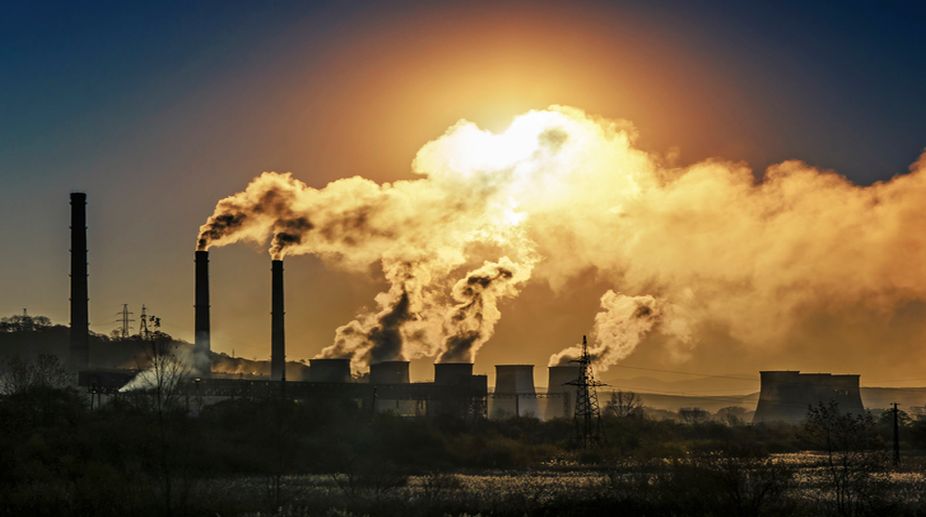The report titled ‘Indians choking on dirty air’ (The Statesman, 20 February) highlights the poor quality of air in India coupled with appalling mismanagement of the environment. The air that Indians breathe is becoming increasingly toxic and there are, on an average, two deaths each day due to air pollution, according to the reputed medical journal, The Lancet. More than a million Indians die or are at the point of death due to air pollution and India is home to some of the world’s worst polluted cities, including its Capital.
The exposure to sub-particulate matter ~ PM 2.5 ~ is to be blamed for this menace and climate change is associated with this phenomenon. The smog, fog and smoke contamination in northern India is also taking a heavy toll. In all the major cities ~ New Delhi, Patna, Kolkata. Mumbai, Chennai ~ the index of air pollution is deeply distressing.
The Lancet has contradicted Indian reports and has pointed out that coalfired power plants contribute to 50 per cent of the air pollution. The emissions from vehicles are also responsible. The contaminated polynuclear aromatic hydrocarbons (PAH) are extremely carcinogenic. The Lancet report mentioned the potential risk to human health and the need for effective and meaningful environment management.
Air pollution in Kolkata, as reported by the World Health Organization and UNEP (United Nations Environment Programme) has assumed alarming proportions, indeed second to Delhi. Although certain measures have been initiated in the Capital, such as the use of natural gas (CNG) and tree plantation, Kolkata has done virtually nothing to counter the menace. The air we breathe is poisoned with anthropogenic and natural emissions.
However, air pollution is not a new problem. As long as man has lived in cities, he has developed a propensity to pollute the environment. It is a problem of the ever-expanding technological society. Artificial impurities are largely injected into the atmosphere at or near the earth’s surface. Therefore, what is critical about air pollution is its scope and severity. It is well known that for most pollutants the troposphere cleanses itself within a very short period of time because of the so-called “vertical missing tendency”. The rainfall also helps in removing the impurities to a certain extent, but acid rain damages the environment, and this is now a matter of grave concern. Therefore, any substance that is not part of air’s gaseous make-up is regarded as a pollutant. Air-borne suspended particulate matter (SPM), respiratory particulate matter (RPM), and contaminant gases exist in the atmosphere in various degrees. Air pollution is not confined to a particular territory but it is a trans-boundary phenomenon. In the major urban cities, the quality of the air has been deteriorating rapidly over the past two decades.
The problem is particularly acute in cities and suburbs where the air is unclean, according to standards fixed by WHO. The city’s burgeoning population, expected to be around 15 million by 2020, is posing a serious problem. Emission from vehicles has been identified as the major source of pollution in the Kolkata metropolitan region. It is responsible for nearly 60 per cent of the city’s total pollution level. The situation is appalling owing to the increasing number of vehicles and the limited space for their movement.
Domestic consumption of fossil fuels, sometimes out in the open and pollutants from small industries and godowns are further accentuating the problem. These pollutants vary from one place to another. Its intensity is most dense in the heart of the city. The common air pollutants in Kolkata are sulphur dioxide, oxides of nitrogen, carbon monoxide, hydrocarbons, heavy metals and traces of carcinogenic polynuclear aromatic hydrocarbons (PAH).
In order to minimise the effect of air pollution and make Kolkata a better place to live, work and invest in, the British Overseas Development Administration had advanced certain recommendations, called the Calcutta Environment Management Strategy and Action Plan (CEMSAP), decades ago. It has identified auto-emissions from vehicles of outmoded technologies as solely responsible for environmental hazards. The CEMSAP has also pointed out that the 24-hour average concentration of SPM, sulphur dioxide, nitrogen oxides, carbon monoxide and hydrocarbons in some places of Kolkata in its maximum level are far above the limits of the Central and State Pollution Control Boards. The air pollution index (API), according to CEMSAP, is the highest at the Howrah Bridge approach, followed by the BBD Bag area. The CEMSAP envisaged that autoemission control, air quality monitoring and dissemination are inter-related.
In its consolidation phase document, CEMSAP has put forward its proposal for effective and meaningful implementation. The road-side air quality is far worse than the air quality standards for all pollutants.
The poor and the weaker sections of society are acutely affected by pollution. The pavement dwellers, underprivileged and vulnerable groups are exposed to direct health hazards. In addition, the heavy air pollution leads to higher rates of mortality and morbidity. Lead petrol has been banned in most developed countries. But unleaded petrol has other disadvantages which need to be addressed.
Lead-free petrol releases a higher level of aromatic organic compounds and a high concentration of benzene which is known to be potentially carcinogenic. According to WHO, the risk of cancer is substantial. Suitable measures need to be taken immediately to eliminate the emission of toxic benzene into the air.
Given the horrifying level of air pollution, how is it that millions still manage to survive? One probable explanation is that the ambient air pollutants are shared by the people and they act as biological filters. The body doesn’t immediately suffer any symptoms of danger, but they do arise after a prolonged period of time.
As the pollutants are chiefly the outcome of auto-emissions, the entire regulatory process needs to be revamped immediately. Reduction of vehicular emissions through continuous checks, strict enforcement of the law and periodical checks of the emission control equipment are absolutely necessary. The air quality monitoring process should be strengthened.
Vehicles, that are run on outdated technology, should be immediately discarded. Special emphasis should be given to the use of natural gas (CNG) effectively and meaningfully. The use of catalytic converters inside a car exhaust system also has its benefits. The use of lead-free petrol in cars without converters poses a risk to public health. Personal exposure to benzene at service stations should be minimised. All service stations must display warnings about the risk of benzene exposure.
Some years back the Green Bench of Kolkata High Court directed that no fuel, be it petrol or diesel, will be given to any vehicles of the city unless they furnish pollution control certificates. It also raised a pertinent question as to why compressed natural gas (CNG) is not used in Kolkata, and slammed the authorities for their lackadaisical attitude towards air pollution in the city.
Planting more trees can cleanse the air. The quality of fuel can also curb air pollution. Its samples need to be analysed regularly. The infrastructure must be suitably developed. The equipment for continuous auto-emission control, including mobile laboratories, need to be utilised properly. Display of air quality information boards in the prime areas of the city can also lead to awareness.
Finally, the success of mitigating air pollution depends largely on people’s involvement and awareness of the environmental health hazards emanating from autoemission.
The writer, a former reader in chemistry at Presidency College, kolkata, was associated with the University Grants Commission and UNICEF.











